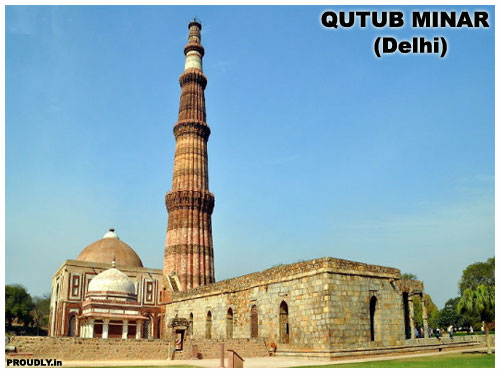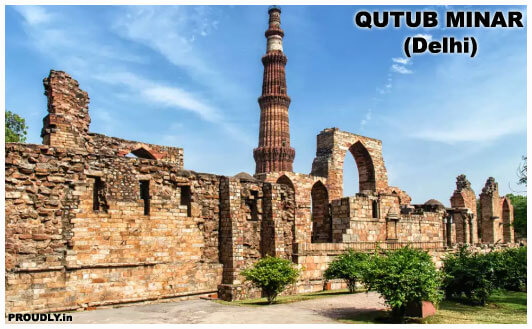Qutub Minar: History, Info, Entry Timings, and Ticket Price

Qutub Minar, after the Red Fort, is the most sought-after spot by tourists who come to Delhi. It is 72.5 meters high and one has to climb 379 steps to get to the top. The diameter of the base is 14.3 meters while the top floor measures 2.7 meters in diameter.
After an accident some years ago in which many school children died, no one is permitted to go inside the minar. The minar was said to have been built to celebrate the victory of Mohammed Ghori, the invader from Afghanistan, over the Rajputs in 1192 and it was partly completed by his viceroy, Qutabuddin Aibak (1192 98), the first sultan of the slave dynasty.
After his death, the rest was completed by Iltutmish, another Muslim king. It stands just outside the central courtyard of Quwwatul Masjid and it was meant to function as a minar so that the muezzin could call the faithful to prayer and also as a symbol of the military might of the turko-Afghan slave dynasty.
Lightning knocked off the uppermost floor in 1368, it was left to Firozshah Tughlak to restore and also add two floors, which introduced white marble in the otherwise red and buff sandstone exterior.
In the early 19th century, an earthquake destroyed the crowning cupola which was replaced by an English engineer, Major Smith. But it looked so out of place that the then General, lord Hardinge ordered its removal. Today it stands on the lawns close to the minar.

The Qutub Minar is identified with Delhi, as the leaning Tower is associated with the city of Pisa or the Eiffel Tower with Paris. It is not only an important tourist spot in Delhi, but it is also an excellent example of early Islamic architecture in India. The area around Qutub Minar has a number of important monuments and together they constitute the Qutub complex.
The Qutub Minar apart from being a marvel in itself is also significant for what it represents in the history of Indian culture. In many ways, the Qutub Minar, the first monument of Muslim rule in India, heralded the beginning of a new style of art and architecture that came to be known as the Indo-Islamic style.
Indo-Islamic style is neither a local variant of Islamic art nor a modification of Hindu art it is an assimilation of both styles, though not always to an equal degree.
It is so because each region in India has its own form of Indo –Islamic architecture, which varies from place to place and there is no standardization. On the other hand, Islamic art itself was a composite style, which had various Muslim influences Turkish, Persian, and Arabic.
Rulers from different parts of the Muslim world, who came to India and settled here, brought with them the artistic traditions of their regions. The intermingling of such traditions with local Indian practices resulted in different examples of indo-Islamic art.
Delhi, Islamic influences dominated while in the Deccan, local styles were more prominent in the buildings. In Bengal, the indigenous practice of using bricks for building was adopted and the monuments were richly decorated with chiseled and molded decorations typical of Hindu temples.
This amalgamation of exotic and indigenous architectural styles was possible due to a variety of factors the Muslim rulers had to use, in most cases Indian craftsmen and sculptors who were schooled in their own artistic tradition.
Though both the Indian and Islamic styles have their own distinctive features, some common characteristics made fusion and adaptation easy. Both styles are marked by the presence of an open court encompassed by chambers or colonnades.
The Qutub Minar and the other building surrounding it are fine examples of the Delhi style of Indo-Islamic art and architecture. Most of these edifices were the first of their kind in India, be they mausoleums, mosques, or madrassas.
The Qutub Minar is a fluted red sandstone tower, which tapers up to a height of 72.5m and is covered with intricate carvings and verses from the Holy Quran. Qutbu-ud-din Aibak began constructing this victory tower as a sign of a Muslim priest, the muezzin to call the faithful to prayer.
However, only the first story was completed by Qutb-ud-din the other stories were built by his successor Iltutmish. The two circular stories in white marble were built by Ferozshah Tuglaq in 1368, replacing the original fourth story.
The projected balconies in the tower are supported by exquisite stalactite designs. The tapering tower has pointed and circular flutings on the first story round and star-shaped on the second and third stories. The bands of the calligraphic inscription are amazing in perfection with the exquisite stalactite designs seen on the exterior of this tower.

However, there are a number of monuments within the Qutub complex apart from the Qutub Minar;
Quuwat-ul-Islam Mosque: The Quuwat-ul-Islam Mosque was the first mosque to be built in India. Both Indian and Islamic features are present.
The mosque is in ruins today but one can see indigenous corbelled arched, floral motifs, as well as Islamic practices such as squinches (setting arches diagonally to a square to support a dome), calligraphy, and geometric patterns.
IItutmish Tomb: To the west of the Quuwat-ul –Islam mosque is another remarkable building the tomb of IItutmish, which was built by the monarch himself in 1235. This building was definitely a departure from the norm, for the concept of building huge mausoleums was new.
The rather plain exterior conceals an interior with many interesting examples of the indo Islamic style. There is a fusion of Indian and Islamic decorative motifs-the lotus and the wheel belonging to the former tradition and geometric arabesque patterns and calligraphy from the latter genre.
The dome no longer exists as it has collapsed the corbelled squinches testify to an early amalgamation that went wrong, a flaw that characterizes early Indo-Islamic architecture.
4th-Centure Iron Pillar: Any write-up on the Qutub Minar will be incomplete without mentioning the 4th century Iron pillar, 7.2m high and 37 cm in diameter, which stands in the courtyard of the Quuwat-ul-Mosque. This pillar, with its distinctly Hindu inscriptions from the Gupta period, is said to have been transported here, but its origins remain a mystery.
Another mystifying factor is that despite being exposed to the elements, the pillar has remained rust free. According to popular belief, anyone who stands with his back to the pillar and encircles it with his arms will have his wish granted one can see visitors to the Qutub Minar trying their luck at the pillar.
Alai Darwaza and the Alai Minar: Later monuments in this complex include the Alai Darwaza and the Alai Minar built by Ala-ud-din khilji (1296-1316).
The Alai Darwaza is a magnificent gateway with inlaid marble decoration and latticed stone screens that display the remarkable artistry of the Turkish artisans who work on it.
The Alia Minar was conceived of as a greater power than the Qutub Minar, but its construction was abandoned after the completion of the 24.5m high first story.
Qutub Complex: The other tombs in the Qutub Minar complex include those of Alauddin Khilji, Imam Zambian, a Sufi saint from Turkestan who came to India during the reign of Sikandar Lodi (1488 1517), and Mohammed Quli Khan, one of Akbar’s courtiers. Also nearby are Alauddin Khilji’s mausoleum and a madrassa.
The Qutub complex, incidentally, is built on the ruins of Lal Kot in the city of Dillika, the capital of the Rajput Tomars and the Chauhan, who were the last Hindu rulers of Delhi. This is further borne out by the fact that since medieval times, seven different cities.
Entry Timings:
07:00 A.M to 05:00 P.M (every day)
Entry Ticket Fee:
Rs.30/- for Indian Citizens and Rs.500/- for foreigners












 Previous Post
Previous Post Next Post
Next Post